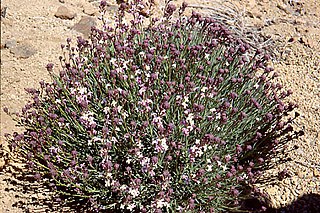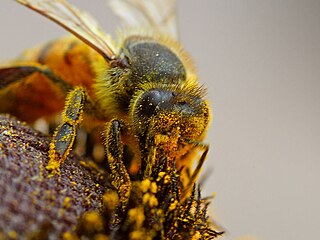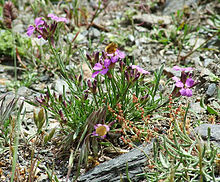
Erysimum, or wallflower, is a genus of flowering plants in the cabbage family, Brassicaceae. It includes more than 150 species, both popular garden plants and many wild forms. The genus Cheiranthus is sometimes included here in whole or in part. Erysimum has since the early 21st century been ascribed to a monogeneric cruciferous tribe, Erysimeae, characterised by sessile, stellate (star-shaped) and/or malpighiaceous (two-sided) trichomes, yellow to orange flowers and multiseeded siliques.

Primula vulgaris, the common primrose, is a species of flowering plant in the family Primulaceae, native to Eurasia. The common name is primrose, or occasionally common primrose or English primrose to distinguish it from other Primula species referred to as primroses.

Myrmecophytes are plants that live in a mutualistic association with a colony of ants. There are over 100 different genera of myrmecophytes. These plants possess structural adaptations that provide ants with food and/or shelter. These specialized structures include domatia, food bodies, and extrafloral nectaries. In exchange for food and shelter, ants aid the myrmecophyte in pollination, seed dispersal, gathering of essential nutrients, and/or defense. Specifically, domatia adapted to ants may be called myrmecodomatia.

Entomophily or insect pollination is a form of pollination whereby pollen of plants, especially but not only of flowering plants, is distributed by insects. Flowers pollinated by insects typically advertise themselves with bright colours, sometimes with conspicuous patterns leading to rewards of pollen and nectar; they may also have an attractive scent which in some cases mimics insect pheromones. Insect pollinators such as bees have adaptations for their role, such as lapping or sucking mouthparts to take in nectar, and in some species also pollen baskets on their hind legs. This required the coevolution of insects and flowering plants in the development of pollination behaviour by the insects and pollination mechanisms by the flowers, benefiting both groups. Both the size and the density of a population are known to affect pollination and subsequent reproductive performance.

Chamaerops is a genus of flowering plants in the family Arecaceae. It contains only one species, Chamaerops humilis, variously called European fan palm or the Mediterranean dwarf palm. It is one of the most cold-hardy palms and is used in landscaping in temperate climates.

A flower, also known as a bloom or blossom, is the reproductive structure found in flowering plants. Flowers consist of a combination of vegetative organs – sepals that enclose and protect the developing flower, petals that attract pollinators, and reproductive organs that produce gametophytes, which in flowering plants produce gametes. The male gametophytes, which produce sperm, are enclosed within pollen grains produced in the anthers. The female gametophytes are contained within the ovules produced in the carpels.

In zoology, a nectarivore is an animal which derives its energy and nutrient requirements from a diet consisting mainly or exclusively of the sugar-rich nectar produced by flowering plants.

Asclepias asperula, commonly called antelope horns milkweed or spider milkweed, is a species of milkweed native to the Southwestern United States and northern Mexico.

In zoology, a palynivore /pəˈlɪnəvɔːɹ/, meaning "pollen eater" is an herbivorous animal which selectively eats the nutrient-rich pollen produced by angiosperms and gymnosperms. Most true palynivores are insects or mites. The category in its strictest application includes most bees, and a few kinds of wasps, as pollen is often the only solid food consumed by all life stages in these insects. However, the category can be extended to include more diverse species. For example, palynivorous mites and thrips typically feed on the liquid content of the pollen grains without actually consuming the exine, or the solid portion of the grain. Additionally, the list is expanded greatly if one takes into consideration species where either the larval or adult stage feeds on pollen, but not both. There are other wasps which are in this category, as well as many beetles, flies, butterflies, and moths. One such example of a bee species that only consumes pollen in its larval stage is the Apis mellifera carnica. There is a vast array of insects that will feed opportunistically on pollen, as will various birds, orb-weaving spiders and other nectarivores.

Erysimum mediohispanicum is a perennial short-lived monocarpic herb found in many montane regions of eastern Spain where it is distributed between 800–2,000 m above sea level and inhabits forests, scrublands, and shrublands. It occupies two main regions in the Iberian Peninsula, one in the north and the other in the south-east. Erysimum mediohispanicum may be treated as one of a group or complex of six closely related species, or as Erysimum nevadense subsp. mediohispanicum.

Erysimum nevadense is a perennial short-lived herb endemic to the Sierra Nevada of Spain, although there are some citations in the nearby Sierra de Gádor (Almería). This wallflower occurs between 1,700 and 2,700 m above sea level in subalpine scrublands and alpine meadows. It may be treated as a narrowly circumscribed single species, one of a group or complex of six separate species, or as a more broadly circumscribed species with six subspecies.

Erysimum popovii is a perennial short-lived herb endemic to several mountain ranges of southeastern Spain, in the Jaén, Granada and Córdoba provinces. This species was discovered in 1926 in Sierra Mágina and it is included in the Red Book of Andalusian Plants, under the category of Insufficient Data. Some accepted synonyms are: Erysimum linifolium subsp. baeticum and Erysimum linifolium sensu Willk., p. min. p.

Chamaecrista fasciculata, the partridge pea, is a species of legume native to most of the eastern United States. It is an annual which grows to approximately 0.5 meters tall. It has bright yellow flowers from early summer until first frost, with flowers through the entire flowering season if rainfall is sufficient.

Polygala lewtonii is a rare species of flowering plant in the milkwort family known by the common name Lewton's polygala, or Lewton's milkwort. It is endemic to Florida in the United States, where it is limited to the central ridge of the peninsula. There are about 49 occurrences of the plant remaining. Most occurrences contain very few plants. The species is threatened by the loss and degradation of its habitat. This is a federally listed endangered species of the United States.

Trollius laxus is a rare flowering plant species in the buttercup family, Ranunculaceae. It is native to North America and is considered to have two subspecies, one with a distribution is the east and one in the west. Common names for Trollius laxus include American globeflower and American spreading globeflower. The American Globeflower, Trollius laxus is an endangered species of flowering plants Native to Northeastern United States. This species of plants is limited in range by their ability to exclusively survive in wetlands and marshes. Thus, clusters of the species are constantly threatened by the ever-changing hydrology of the range they are confined to.

In evolutionary biology, mimicry in plants is where a plant organism evolves to resemble another organism physically or chemically, increasing the mimic's Darwinian fitness. Mimicry in plants has been studied far less than mimicry in animals, with fewer documented cases and peer-reviewed studies. However, it may provide protection against herbivory, or may deceptively encourage mutualists, like pollinators, to provide a service without offering a reward in return.
Sexual selection is described as natural selection arising through preference by one sex for certain characteristics in individuals of the other sex. Sexual selection is a common concept in animal evolution but, with plants, it is oftentimes overlooked because many plants are hermaphrodites. Flowering plants show many characteristics that are often sexually selected for. For example, flower symmetry, nectar production, floral structure, and inflorescences are just a few of the many secondary sex characteristics acted upon by sexual selection. Sexual dimorphisms and reproductive organs can also be affected by sexual selection in flowering plants.

Parkia pendula is a species of neotropical evergreen tree found throughout Central and South America. It is part of the Parkia genus, a group of flowering plants that are part of the legume family, Fabaceae.

Protea pruinosa, also known as frosted sugarbush or burnished protea, is a flowering shrub which belongs to the genus Protea within the botanical family Proteaceae. The plant is endemic to the southwestern Cape Region of South Africa.

Pollinator-mediated selection is an evolutionary process occurring in flowering plants, in which the foraging behavior of pollinators differentially selects for certain floral traits. Flowering plant are a diverse group of plants that produce seeds. Their seeds differ from those of gymnosperms in that they are enclosed within a fruit. These plants display a wide range of diversity when it comes to the phenotypic characteristics of their flowers, which attracts a variety of pollinators that participate in biotic interactions with the plant. Since many plants rely on pollen vectors, their interactions with them influence floral traits and also favor efficiency since many vectors are searching for floral rewards like pollen and nectar. Examples of pollinator-mediated selected traits could be those involving the size, shape, color and odor of flowers, corolla tube length and width, size of inflorescence, floral rewards and amount, nectar guides, and phenology. Since these types of traits are likely to be involved in attracting pollinators, they may very well be the result of selection by the pollinators themselves.



















